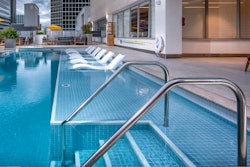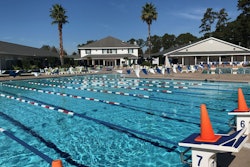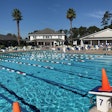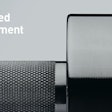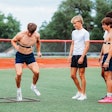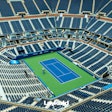SOURCE: National Athletic Trainers' Association
DALLAS, April 26, 2018 – With baseball season well underway and numerous shoulder injuries already reported, the National Athletic Trainers’ Association (NATA) offers timely recommendations with its newly released position statement, “Evaluation, Management and Outcomes of and Return-to-Play Criteria for Overhead Athletes with Superior Labral Anterior-Posterior Injuries.” Created by the NATA Research & Education Foundation, the document is available online in the Journal of Athletic Training, NATA’s scientific publication.
The labrum of the shoulder joint is important, as it helps to deepen the socket and provides stability for the humerus (arm bone) in its connection to the scapula (shoulder blade). A specific type of labrum injury called a superior labral anterior-posterior (SLAP) lesion is commonly sustained by overhead throwing or hitting athletes such as those participating in baseball, softball, tennis and volleyball. Patients often complain of vague shoulder pain during overhead motions and may have a sensation of popping, clicking or catching. However, the literature indicates that a history of these symptoms alone is not diagnostic of a SLAP lesion. Pain may be generalized to the shoulder or more likely, be described as a deep shoulder pain, and the levels of pain can vary greatly.
Because SLAP lesions are often accompanied by an associated injury such as rotator cuff tendon damage, a definitive diagnosis can be difficult. In fact, one study shows that 72 to 77 percent of individuals with a SLAP injury also had associated injuries. For athletes who do sustain a SLAP injury, the new position statement offers guidelines to inform athletic trainers and other health care providers on the diagnosis, acute and long-term conservative and surgical treatment, as well as expected outcomes and return-to-play guidelines.
According to the position statement, physical examination tests are limited in their ability to diagnose a SLAP tear. However, the tests, especially a combination of them, may aid diagnosis. Once diagnosed, nonoperative management that includes rehabilitation, nonsteroidal anti-inflammatory drugs and corticosteroid injections is recommended as the first line of treatment for three to six months. The outcomes of surgical and nonoperative management yield high levels of satisfaction and return of shoulder function. However, the ability to return to their overhead sport varied widely, ranging from 20 to 94 percent of patients. Studies show 55 percent of athletes, on average, returned to full participation in their prior sport. In overhead athletes, the average return to prior sport is only 45 percent.
“After a SLAP injury, the goal is to return the athlete to his or her prior level of function given the individual demands of the sport,” says lead author Lori A. Michener, PhD, ATC, PT,professor at the University of Southern California, Los Angeles. The multifactorial assessment of the ability to return to sport is based on the patient’s perception of readiness to return to sport, satisfaction with functional use and outcome, resolution of impairments and physical performance of sport activity.”
Selected Recommendations from the Position Statement
Diagnosis
- Repetitive overhead activities such as throwing or serving cause forces on the labrum because of the biceps muscle attachment near the labrum. This may cause a SLAP lesion.
- Throwing athletes with posterior shoulder tightness may have an increased risk of shoulder injury, including a SLAP lesion.
- A stand-alone finding of a history of popping, clicking or catching is not sufficient to diagnosis a SLAP lesion.
Management
- Patients with SLAP lesions should undergo three to six months of nonoperative management to include rehabilitation aimed at decreasing pain, improving shoulder function and returning to previous activity levels.
- In addition to rehabilitation, nonoperative management may include prescription medications and corticosteroid injections to decrease pain and inflammation in the disabled throwing shoulder.
- A patient who fails to improve after three to six months of nonoperative management can be considered for surgical treatment. Failure to improve is characterized by the inability to regain pain-free shoulder motion and near-normal shoulder strength and inability to return to the prior or desired level of activity.
Outcomes and Return to Play
- Whether the treatment is surgical or nonsurgical, most patients with SLAP lesions can expect to achieve 85 percent of normal function after two to three years.
- To return to full activities, patients will need to regain 90 percent of range of motion.
- The criterion for return to sport activities is primarily based on time. Guidelines suggest a return to sport-specific training begin around four months post-surgery with progression to full activities over the next two to three months.
“Consistency in reporting patient-rated outcomes, the time and level of return to play and the type of treatment used is recommended to adequately and accurately determine successful management of patients with SLAP lesions,” Michener added.
For more information, please visit: www.nata.org or www.atyourownrisk.org
About NATA: National Athletic Trainers’ Association (NATA) – Health Care for Life & Sport
Athletic trainers are health care professionals who specialize in the prevention, diagnosis, treatment and rehabilitation of injuries and sport-related illnesses. They prevent and treat chronic musculoskeletal injuries from sports, physical and occupational activity, and provide immediate care for acute injuries. Athletic trainers offer a continuum of care that is unparalleled in health care. The National Athletic Trainers' Association represents and supports 45,000 members of the athletic training profession. Visit www.nata.org.

















